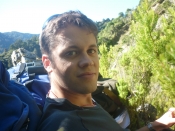Mock trials in the history classroom?
The last term before the summer holidays is usually a difficult one. The senior students have gone, everyone is counting down to the break and everything feels a little looser. There is a tendency to “tighten things up” and teachers are sometimes exhorted to “maintain control” and “not play too many videos”. I decided that this was a good time of the year to make social studies as practical as possible. We started a unit of learning on the criminal justice system and especially the pros and cons of jury service. This posting describes how this evolved into a fully blown mock trial held in the capital city’s Old High Court. Although it was for a civics component of a social studies course, I will start by describing what we did and then discuss some of the implications I think it could have for the teaching of history.
It was during a class visit to the Supreme Court and the Old High Court that students asked if they could put someone on trial. I gained permission from the Ministry of Justice to use the recently beautifully refurbished nineteenth century building and the New Zealand Law Commission also lent us some gowns to add to the effect. Using a set of procedures from a UK website (see attachment) my two classes chose their defendants. One class put the character Scar from The Lion King on trial and the other class put Robin Hood in the dock. Students used the New Zealand Crimes Act to develop two charges for each defendant and then formed teams around the defence and prosecution. They then wrote a script, prepared witnesses and elected a judge, clerk, and usher. Both classes performed their trial on the same day and therefore could act as each other’s jury.
The day was highly successful, each class effectively writing and performing two 45 minute plays in front of an audience of parents, teachers, my school’s senior leadership team, invited lawyers who had helped students to prepare their cases and the local media. The jury from each class then went into the juror’s room and they were recorded deliberating the evidence, which I played them when we got back to school. The whole event meant that students were highly engaged at the end of the school year, which I have always found difficult to achieve. The learning from participating in the mock trial made the overall unit about the criminal justice system and the effectiveness of trial by jury much more real.
The experience left me with two questions. First, to what extent could I have made this unit of learning more powerful by adding an historical dimension to our civics-based learning about jury service and the criminal justice system? Second, to what extent could I develop students’ historical thinking by putting an historical person on trial and dealing with real historical evidence?
Question 1: How can I add an historical dimension to civics education?
Andrew Wren has written a very useful article titled Build it in, don’t bolt it on: History’s opportunity to support critical citizenship (1999). This has helped me a lot to see how an historical dimension to citizenship education can be very powerful. When discussing the ways identity is contested in the United Kingdom, Wrenn argues that “citizenship education will be working when children see how patterns of loyalty and allegiance are constructed, represented or imposed” (p.12). Equally, I think an important component of my criminal justice unit next time will be to examine with students the concept of a fair trial and justice, and to see how those ideas have been constructed, represented or imposed through time. More recently Alan Sears has argued that concepts such as democracy are deeply contested and fluid, understood differently according to time and place. He argues that to understand a concept like democracy, and from this understanding take a position on something we think is important, it helps to appreciate the different ways in which people have comprehended the idea in the past. Next time I teach this social studies unit I will need to respond much more actively to Wrenn’s and Sears’ arguments.
Question 2: To what extent could an historical trial develop students’ historical thinking?
When the new school year starts in January 2014 I am going to put an historical person on trial and track how this develops students’ historical thinking. Instead of running a full unit of the genocide in Rwanda (as partially described in a previous blog post) I will ask students to put President Bill Clinton on trial for failing to prevent the 1994 genocide. There are a number of real sources that the defence and prosecution teams can use to build their arguments and prepare witness statements. This should be a good opportunity for students to use primary source evidence, take historical perspectives and understand ethical dimensions in history. It is also a chance for students to grapple with the concept of historical agency. Could Clinton have prevented the genocide had he wanted to?
There are some risks. The adversarial approach of our court system is not usually how historians operate. I also want to find a charge under international law that is relevant, instead of using the New Zealand Crimes Act. Having carried out a reasonably ambitious project with my two social studies classes, I am ready to try and practically answer my second question. If anyone has tried this before I would very much appreciate some tips!
References
Sears, A, accessed on December 16, 2013 from http://thenhier.ca/en/content/battle-lines-schools-teaching-history-war-and-society-common-good-0
Wrenn, A. (1999), ‘Build it in, don’t bolt it on: History’s opportunity to support critical citizenship’, in Teaching History, 96.


